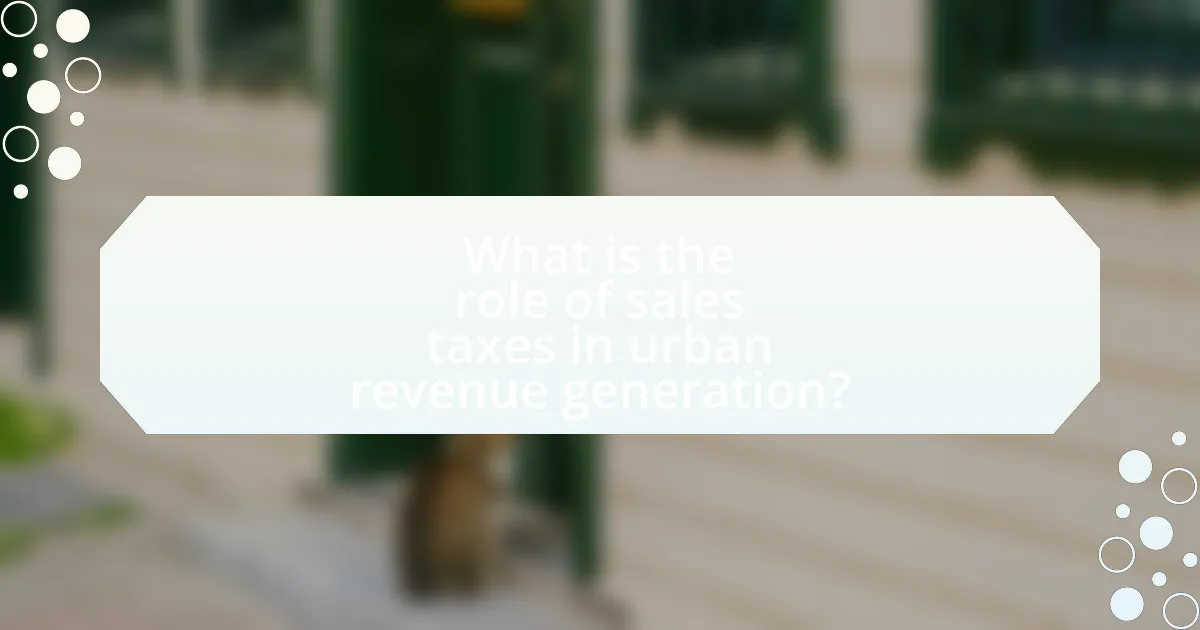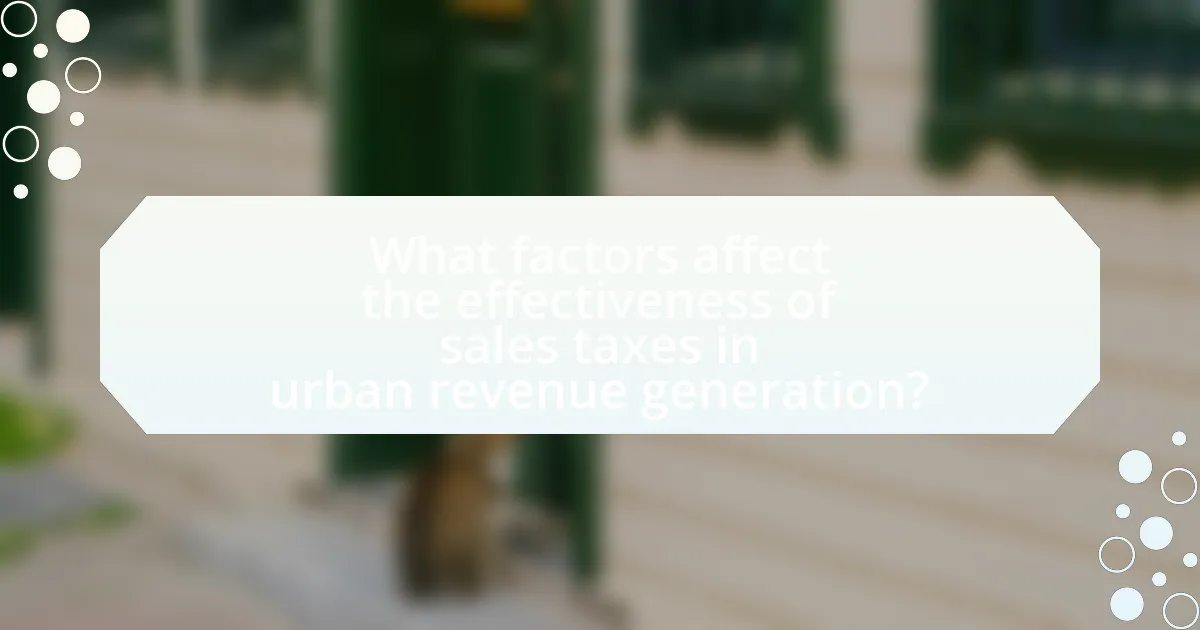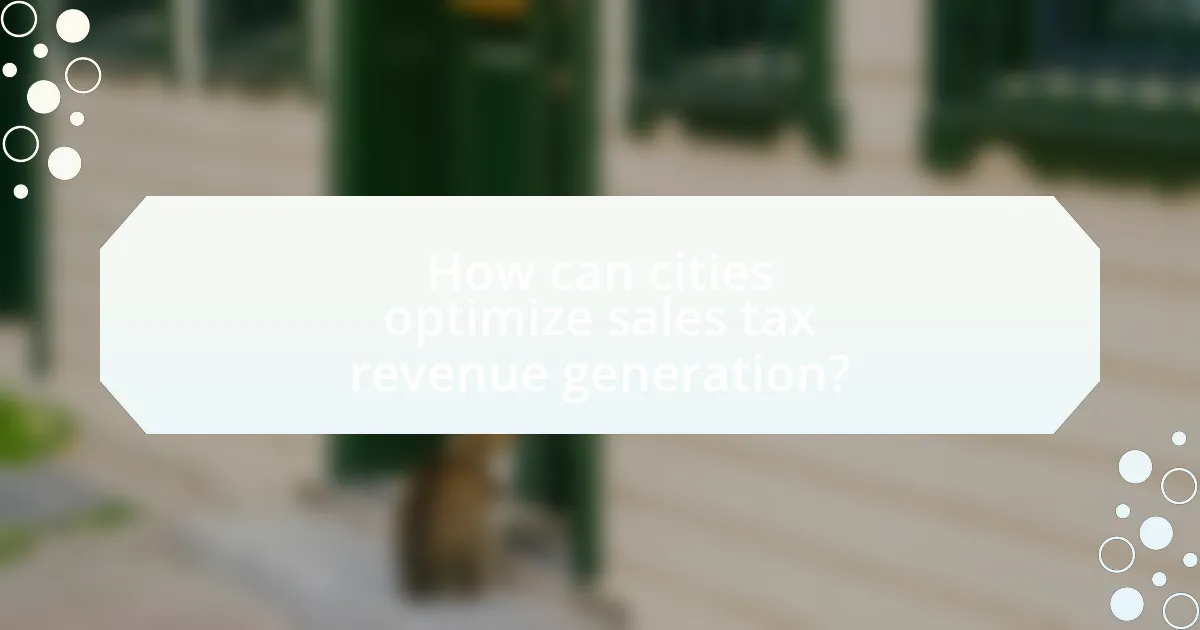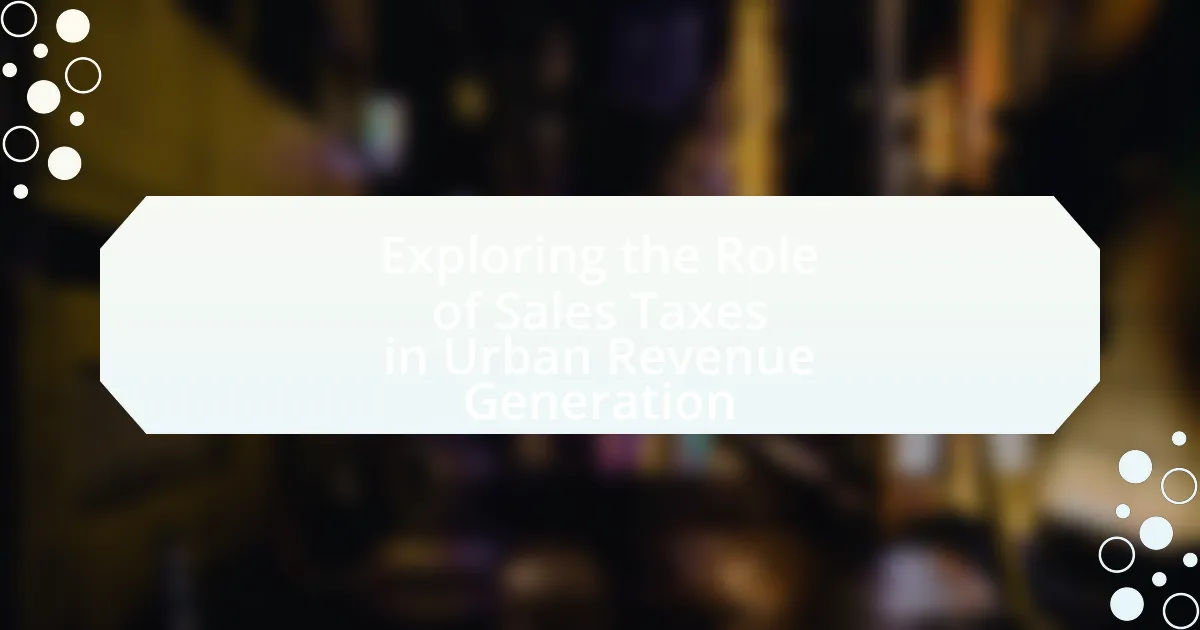Sales taxes are a vital source of revenue for urban areas, significantly contributing to local government funding for essential services such as education, public safety, and infrastructure. This article explores the role of sales taxes in urban revenue generation, detailing how they impact overall revenue, the primary sources of sales tax, and the variations in tax rates across different cities. It also examines the influence of demographic trends, consumer spending habits, and economic conditions on sales tax revenue, while addressing the challenges cities face in implementing and collecting these taxes. Furthermore, the article discusses strategies for optimizing sales tax revenue generation and highlights future trends in sales tax legislation and enforcement.

What is the role of sales taxes in urban revenue generation?
Sales taxes play a crucial role in urban revenue generation by providing a significant source of funding for local governments. These taxes are levied on the sale of goods and services, contributing to the overall budget that supports essential services such as public safety, infrastructure maintenance, and education. For instance, in the United States, sales tax revenue accounted for approximately 31% of state and local tax collections in 2020, highlighting its importance in financing urban initiatives. This revenue is particularly vital for cities, as it helps address budget shortfalls and supports economic development projects that enhance community welfare.
How do sales taxes contribute to the overall revenue of urban areas?
Sales taxes significantly contribute to the overall revenue of urban areas by providing a stable source of funding for local government services and infrastructure. In many urban settings, sales tax revenue accounts for a substantial portion of the budget, often ranging from 20% to 50% of total revenue, depending on the municipality. This revenue is essential for financing public services such as education, public safety, and transportation. For instance, in 2020, the National Conference of State Legislatures reported that states collected approximately $400 billion in sales tax revenue, a significant share of which is allocated to urban areas. This financial support enables cities to maintain and improve essential services, thereby enhancing the quality of life for residents.
What are the primary sources of sales tax revenue in cities?
The primary sources of sales tax revenue in cities are retail sales, services, and accommodations. Retail sales, which include the sale of goods in stores, account for the largest portion of sales tax revenue, often exceeding 60% in many urban areas. Services, such as personal services and professional services, contribute significantly as well, particularly in cities with a strong service economy. Accommodations, including hotels and short-term rentals, also generate substantial sales tax revenue, especially in tourist-heavy cities. These sources collectively form the backbone of sales tax revenue, providing essential funding for local government services and infrastructure.
How do sales tax rates vary across different urban areas?
Sales tax rates vary significantly across different urban areas, reflecting local government policies and economic conditions. For example, as of 2023, cities like Los Angeles have a sales tax rate of 10.25%, while New York City has a rate of 8.875%. These differences arise from various factors, including state laws, local government needs, and economic strategies aimed at revenue generation. Additionally, urban areas may implement additional local taxes on top of state rates, further contributing to the variation. For instance, Chicago’s total sales tax rate is 10.25%, which includes both state and local taxes. Such disparities illustrate how urban areas tailor their sales tax rates to meet specific fiscal requirements and economic goals.
Why are sales taxes important for urban development?
Sales taxes are crucial for urban development because they provide a significant source of revenue for local governments, enabling funding for essential services and infrastructure projects. This revenue supports public services such as education, transportation, and public safety, which are vital for maintaining and improving urban living conditions. For instance, according to the U.S. Census Bureau, local governments collected approximately $200 billion in sales tax revenue in 2020, highlighting its importance in financing urban initiatives. Additionally, sales taxes can stimulate economic growth by attracting businesses and residents, as well-maintained infrastructure and services enhance the overall appeal of urban areas.
What impact do sales taxes have on public services and infrastructure?
Sales taxes significantly impact public services and infrastructure by providing essential funding for local governments. These taxes generate revenue that supports various public services, including education, public safety, and transportation infrastructure. For instance, in the United States, sales tax revenue accounted for approximately 31% of state and local tax collections in 2020, according to the U.S. Census Bureau. This funding is crucial for maintaining and improving roads, bridges, and public transit systems, which are vital for urban development and economic growth. Additionally, the reliance on sales taxes can lead to fluctuations in revenue based on economic conditions, affecting the stability and quality of public services and infrastructure over time.
How do sales taxes influence economic growth in urban settings?
Sales taxes can both positively and negatively influence economic growth in urban settings. On one hand, sales taxes generate significant revenue for local governments, which can be reinvested into public services, infrastructure, and community development, thereby stimulating economic activity. For instance, a study by the National Bureau of Economic Research found that increased public spending funded by sales tax revenue can lead to higher local employment rates and increased consumer spending.
On the other hand, high sales tax rates may deter consumer spending and discourage businesses from establishing or expanding in urban areas. Research from the Tax Foundation indicates that cities with higher sales taxes may experience slower economic growth due to reduced disposable income for consumers and increased operational costs for businesses. Thus, the influence of sales taxes on economic growth in urban settings is complex, balancing revenue generation with potential impacts on consumer behavior and business investment.

What factors affect the effectiveness of sales taxes in urban revenue generation?
The effectiveness of sales taxes in urban revenue generation is influenced by several key factors, including the tax rate, compliance levels, economic conditions, and the breadth of the tax base. A higher sales tax rate can lead to increased revenue, but it may also discourage consumer spending, impacting overall sales. Compliance levels, which refer to how well businesses and consumers adhere to tax regulations, directly affect revenue; for instance, a study by the Institute on Taxation and Economic Policy found that states with higher compliance rates generate significantly more revenue. Economic conditions, such as employment rates and consumer confidence, also play a crucial role; during economic downturns, sales tax revenues typically decline as spending decreases. Lastly, a broader tax base, which includes more goods and services subject to sales tax, can enhance revenue generation by capturing a larger share of consumer spending.
How do demographic trends influence sales tax revenue?
Demographic trends significantly influence sales tax revenue by affecting consumer spending patterns and the overall economic activity within a region. For instance, an increase in population typically leads to higher demand for goods and services, which in turn boosts sales tax collections. According to the U.S. Census Bureau, areas experiencing population growth often see corresponding increases in retail sales, as more residents contribute to the local economy. Additionally, demographic factors such as age distribution, income levels, and household composition can shape spending habits; for example, younger populations may spend more on technology and entertainment, while older demographics might focus on healthcare and services. This variation in spending directly impacts the types of goods and services subject to sales tax, thereby influencing overall revenue.
What role does population density play in sales tax collection?
Population density significantly influences sales tax collection by affecting consumer spending patterns and the number of retail establishments. Higher population density typically leads to increased foot traffic and a larger customer base for businesses, which can result in higher sales volumes and, consequently, greater sales tax revenue. For instance, urban areas with dense populations often have more retail outlets per capita, enhancing the likelihood of sales transactions that generate tax revenue. According to the U.S. Census Bureau, metropolitan areas with higher population densities tend to report higher sales tax collections, demonstrating a direct correlation between density and revenue generation.
How do consumer spending habits affect sales tax revenue?
Consumer spending habits directly influence sales tax revenue by determining the volume and type of taxable purchases made. When consumers increase their spending, particularly on goods and services subject to sales tax, the revenue generated from these taxes rises correspondingly. For instance, in the United States, a 1% increase in consumer spending can lead to an estimated increase of $1.5 billion in sales tax revenue, as reported by the National Conference of State Legislatures. Conversely, if consumer spending declines, such as during economic downturns, sales tax revenue typically decreases, impacting urban revenue generation significantly. This relationship underscores the importance of consumer behavior in shaping fiscal outcomes for local governments.
What challenges do cities face in implementing sales taxes?
Cities face several challenges in implementing sales taxes, primarily including public opposition, administrative complexity, and economic impact concerns. Public opposition arises from residents who may view sales taxes as an additional financial burden, leading to resistance during the approval process. Administrative complexity involves the need for cities to establish systems for tax collection, compliance monitoring, and enforcement, which can strain existing resources. Economic impact concerns stem from fears that higher sales taxes could deter consumers and businesses, potentially leading to reduced economic activity. For instance, a study by the National Conference of State Legislatures indicates that cities with higher sales tax rates may experience slower retail growth compared to those with lower rates, highlighting the delicate balance cities must maintain when considering sales tax implementation.
How do economic downturns impact sales tax revenue?
Economic downturns significantly reduce sales tax revenue due to decreased consumer spending. During such periods, individuals and businesses often cut back on expenditures, leading to lower sales in retail and service sectors, which directly impacts the amount of sales tax collected. For instance, the National Bureau of Economic Research reported that during the 2008 financial crisis, states experienced an average decline of 10% in sales tax revenue as consumer confidence plummeted and unemployment rates rose. This correlation illustrates how economic contractions lead to diminished fiscal resources for urban areas reliant on sales taxes for funding essential services.
What are the administrative challenges of collecting sales taxes?
The administrative challenges of collecting sales taxes include complexity in compliance, varying tax rates, and enforcement difficulties. Compliance is complicated by the need for businesses to understand and apply different tax rates across jurisdictions, as over 10,000 sales tax jurisdictions exist in the United States alone. Additionally, businesses often face challenges in accurately reporting and remitting taxes due to frequent changes in tax laws and regulations. Enforcement is also problematic, as it requires significant resources to audit businesses and ensure compliance, particularly for small businesses that may lack the capacity to manage tax obligations effectively. These challenges can lead to revenue losses for municipalities and increased administrative costs.

How can cities optimize sales tax revenue generation?
Cities can optimize sales tax revenue generation by implementing targeted tax policies, enhancing compliance measures, and investing in local economic development. Targeted tax policies, such as adjusting tax rates for specific sectors or incentivizing businesses to locate in certain areas, can attract more consumers and businesses, thereby increasing sales tax revenue. For instance, cities that have lowered sales tax rates for essential goods have seen increased consumer spending, which directly boosts tax revenue.
Enhancing compliance measures, such as improving auditing processes and utilizing technology for tracking sales, can significantly reduce tax evasion. According to the Government Accountability Office, states that have adopted automated sales tax systems have reported a 10-15% increase in compliance rates, leading to higher revenue.
Investing in local economic development initiatives, such as supporting small businesses and promoting tourism, can also drive sales tax growth. Research from the National League of Cities indicates that cities that actively promote local businesses see a 20% increase in sales tax revenue over five years. By focusing on these strategies, cities can effectively optimize their sales tax revenue generation.
What strategies can urban areas adopt to enhance sales tax collection?
Urban areas can enhance sales tax collection by implementing technology-driven solutions, improving compliance enforcement, and fostering community engagement. Technology-driven solutions, such as point-of-sale systems that automatically calculate and report sales tax, can streamline the collection process. For instance, cities that have adopted electronic sales tax reporting have seen increases in compliance rates by up to 20%. Improving compliance enforcement through regular audits and targeted outreach to businesses can also significantly boost collections; studies show that proactive enforcement can increase revenue by 15% to 30%. Lastly, fostering community engagement through educational campaigns about the importance of sales tax for local services can encourage voluntary compliance, as evidenced by programs in cities like San Francisco, which reported a 10% increase in voluntary payments after community outreach initiatives.
How can technology improve sales tax compliance and collection?
Technology can improve sales tax compliance and collection by automating tax calculations and reporting processes. Automated systems reduce human error, ensuring accurate tax rates are applied based on the latest regulations, which is crucial given that 45 states in the U.S. have varying sales tax rates. Additionally, cloud-based solutions enable real-time data access and integration with point-of-sale systems, streamlining the collection process. According to a 2021 report by the Government Accountability Office, states that implemented automated tax systems saw a 20% increase in compliance rates. This demonstrates that leveraging technology not only enhances accuracy but also boosts revenue collection efficiency.
What role do incentives play in boosting sales tax revenue?
Incentives play a crucial role in boosting sales tax revenue by encouraging consumer spending and attracting businesses to a region. When governments offer tax incentives, such as sales tax holidays or reduced rates for certain sectors, they stimulate economic activity, leading to increased sales transactions. For instance, a study by the National Conference of State Legislatures found that states implementing sales tax holidays experienced a notable uptick in retail sales during those periods, directly correlating with higher sales tax collections. Additionally, incentives can attract new businesses, which expand the tax base and generate more revenue. Therefore, the strategic use of incentives effectively enhances sales tax revenue through increased consumer engagement and business investment.
What best practices should cities follow for effective sales tax management?
Cities should implement a comprehensive sales tax management strategy that includes regular audits, accurate data collection, and stakeholder engagement. Regular audits help identify discrepancies and ensure compliance with tax regulations, which is crucial for maintaining revenue integrity. Accurate data collection allows cities to analyze sales trends and adjust tax rates accordingly, optimizing revenue generation. Engaging stakeholders, including local businesses and residents, fosters transparency and encourages compliance, as evidenced by studies showing that community involvement increases tax collection rates. By following these best practices, cities can enhance their sales tax management and improve overall urban revenue generation.
How can cities balance sales tax rates with economic growth?
Cities can balance sales tax rates with economic growth by implementing a tiered tax structure that adjusts rates based on economic conditions and business types. This approach allows cities to maintain revenue while encouraging consumer spending and attracting businesses. For instance, research from the National Conference of State Legislatures indicates that cities with lower sales tax rates often experience higher retail sales growth, as consumers are more likely to spend when tax burdens are minimized. Additionally, cities can periodically review and adjust tax rates based on economic indicators, ensuring that tax policies remain aligned with growth objectives.
What are the key considerations for equitable sales tax policies?
Key considerations for equitable sales tax policies include ensuring fairness, simplicity, transparency, and revenue adequacy. Fairness involves designing tax structures that do not disproportionately burden low-income individuals; for instance, implementing exemptions for essential goods can alleviate this impact. Simplicity is crucial for compliance and administration, as overly complex systems can lead to confusion and increased costs for both taxpayers and the government. Transparency in how tax revenues are utilized fosters public trust and accountability, encouraging compliance. Lastly, revenue adequacy ensures that sales tax policies generate sufficient funds to meet urban service needs, which can be assessed through historical revenue data and economic forecasts.
What are the future trends in sales taxes and urban revenue generation?
Future trends in sales taxes and urban revenue generation indicate a shift towards digital taxation and increased reliance on technology for compliance and collection. As e-commerce continues to grow, municipalities are adapting their sales tax frameworks to capture revenue from online transactions, evidenced by the implementation of laws like the South Dakota v. Wayfair ruling, which allows states to tax sales from out-of-state sellers. Additionally, urban areas are exploring innovative revenue streams, such as congestion pricing and value capture financing, to supplement traditional sales tax revenues. These trends reflect a broader move towards integrating technology and modern economic practices into urban fiscal strategies.
How might e-commerce impact traditional sales tax models in urban areas?
E-commerce significantly impacts traditional sales tax models in urban areas by shifting consumer purchasing behavior from physical stores to online platforms. This shift reduces the taxable sales volume for local businesses, leading to decreased sales tax revenue for urban governments. For instance, a report by the U.S. Government Accountability Office indicated that e-commerce sales accounted for 14% of total retail sales in 2020, highlighting the growing trend. Consequently, urban areas may need to adapt their sales tax structures, potentially implementing measures like destination-based sales tax systems to capture revenue from online transactions more effectively. This adaptation is crucial as it addresses the challenges posed by the increasing prevalence of e-commerce, ensuring that urban revenue generation remains sustainable.
What innovations are emerging in sales tax legislation and enforcement?
Innovations in sales tax legislation and enforcement include the adoption of automated tax compliance systems and the implementation of economic nexus laws. Automated systems streamline the collection and remittance processes, reducing administrative burdens for businesses and increasing accuracy in tax reporting. Economic nexus laws, which establish tax obligations based on sales volume rather than physical presence, have expanded the ability of states to collect taxes from remote sellers, significantly increasing revenue. For instance, following the South Dakota v. Wayfair decision in 2018, many states enacted such laws, resulting in billions in additional sales tax revenue.
What practical tips can urban planners use to enhance sales tax revenue?
Urban planners can enhance sales tax revenue by strategically zoning areas for commercial development, which attracts businesses and increases consumer spending. By implementing mixed-use developments, planners can create vibrant neighborhoods that encourage foot traffic and support local retailers. Additionally, promoting public transportation access to commercial districts can increase visitor numbers, further boosting sales tax collections. Research indicates that cities with well-planned commercial zones experience higher sales tax revenues, as seen in cities like San Francisco, where targeted zoning led to a 20% increase in retail sales over five years.

Leave a Reply